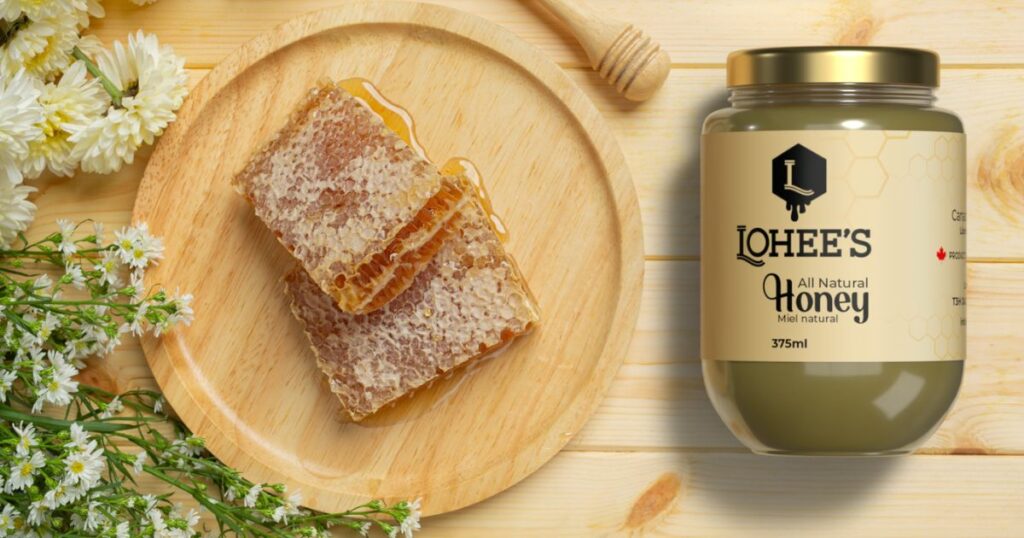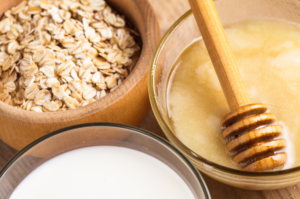Honey 101: Raw Honey and The Science Behind Its Potency
Honey, nature’s sticky gold, has been cherished for centuries for its exquisite taste and numerous health benefits in its raw state.
As people become more mindful of what they eat and drink, raw honey has become popular among conscious eaters who desire natural sweeteners.
Today we will explore raw honey, other types of honey and the science behind raw honey’s potency.
So, grab a cup of tea and join me on this sweet adventure!
What is Raw Honey?
Raw honey is “honey as it exists in the beehive” that may have been slightly strained to remove physical impurities but should not have been excessively heated (pasteurized).
Heating honey above 95°F (35°C) can destroy beneficial enzymes and other substances. So any honey heated past these temperatures is no longer considered raw.
Raw honey without any additives is pure raw honey.

Pasteurized Honey
This honey has undergone heating to a temperature between 145°F (63°C) and 160°F (71°C) and then rapidly cooled to destroy potentially harmful bacteria, yeast, or other microorganisms. This process helps improve the honey’s shelf life, inhibit fermentation, and reduce the risk of crystallization.
Flavoured Honey
Flavoured honey is a type of honey that has been infused with additional natural flavours like fruits, herbs, and spices during the honey production process to enhance its taste and offer varieties different from the good ol’ honey.
Adulterated Honey
This honey has been diluted with substances of lower quality, like corn syrup or high-fructose corn syrup, to increase the volume and decrease the cost.
Shady honey dealers also add artificial flavours and sweeteners to honey to enhance its taste and appearance. But these additives can alter the natural composition of the honey and deceive consumers. Hence these are referred to as fake honey. This practice is considered illegal.
However, In most countries, food safety regulations and standards are in place to ensure the quality and authenticity of honey.
In Canada, the Canadian Food Inspection Agency (CFIA) is responsible for enforcing regulations related to food safety, including honey.
Forms of Raw Honey
Unless you are a beekeeper, you may know only two to three forms of raw honey.
Honey can vary in texture, consistency, and appearance due to the floral source, geographical region, and processing methods. Here are five forms of natural honey and their features:
- Liquid Honey: This is the most common form of honey, typically extracted from the beehive and strained to remove impurities. It has a smooth, runny consistency and pours easily. Depending on the nectar source, liquid honey can vary in colour, ranging from light amber to dark brown.
- Creamed or Whipped Honey: Creamed honey has a thick, creamy texture and a spreadable consistency. It is made by controlling the crystallization process of honey, resulting in fine crystals that give it a smooth and velvety texture. Creamed honey is popular as a spread on bread, toast, or biscuits.

- Comb Honey: Comb honey is still contained within the honeycomb cells. It is honey in its purest form, as the bees have not removed any parts of it. Comb honey is often sold in its natural beeswax comb, making it a unique and visually appealing product.
- Chunk Honey: Chunk honey combines liquid or creamed honey and pieces of comb honey. It provides honey’s sweetness and adds texture and flavour to the honeycomb. Chunk honey is often sold in jars, with the comb honey immersed in the liquid or creamed honey.
- Crystallized Honey: Over time, honey may naturally crystallize or solidify. Crystallized honey has a thick and grainy texture with visible sugar crystals. It can have various consistencies, ranging from fine to coarse, depending on the specific type of honey. Crystallized honey is still perfectly safe to consume and can be easily liquefied by gently warming it.
The Science Behind Raw Honey’s Benefits
Raw Honey is more than just a sweetener. Its composition is an intriguing blend of sugars, enzymes, organic acids, minerals, vitamins, antioxidants, and other beneficial compounds, which is why this sticky gold deserves a place on our shelves and medicine cabinets.
- Sugars: The main sugars in honey are fructose and glucose, which comprise most of its carbohydrate content. These sugars provide the sweet taste and energy content of honey.
- Water: Honey contains varying amounts of water, typically ranging from 17% to 20%. The water content can influence the consistency and stability of honey. Raw honey demonstrates antimicrobial properties due to its low water content, acidic pH, and the presence of certain enzymes, such as glucose oxidase. These properties help inhibit the growth of certain bacteria, fungi, and other microorganisms. As a result, raw honey has been used traditionally for wound healing and to soothe sore throats.
- Enzymes: Bees add enzymes to the nectar during the honey-making process. These enzymes break down complex sugars, converting nectar into honey and contributing to its preservation.
- Minerals and Trace Elements: Honey contains small amounts of minerals and trace elements, including potassium, calcium, magnesium, iron, zinc, and copper. The specific mineral content can differ depending on the floral source of the honey.
- Organic Acids: organic acids play a role in honey’s overall flavour, aroma, and acidity. They also contribute to the preservation and antimicrobial properties of honey. Several organic acids contribute to its acidity and flavour profile. The exact composition can vary depending on the floral source and geographical location.
- Amino Acids: Honey contains a small amount of amino acids, which are the building blocks of proteins. The amino acid composition can vary depending on the nectar sources and other factors.
- Antioxidants: Honey contains antioxidants, such as phenols and flavonoids, which contribute to its potential health benefits that help protect cells from damage caused by free radicals. Antioxidants are like protective shields for our cells that help prevent damage caused by these free radicals which can harm our cells and contribute to problems like chronic diseases and aging. So, antioxidants act as superheroes that defend our cells and keep them healthy
Where To Buy Raw Honey.
Buy honey from beekeepers or trusted brands, like Lohee’s Natural Honey, that carry honey from actual beekeepers. Every jar of our honey is filled from top to bottom with real honey.
Explore the world of authentic raw honey today by visiting our website or follow us on all social media channels @loheesnaturalhoney
